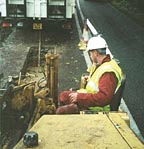
So with a recession on our hands, looming overhead are the big questions: How long will it last? What can we do until HDD work comes back?
Without getting into the complexity of what caused this shortage of HDD work, let me say briefly that telecommunications accounts for much of both the boom we saw in 2000 and the crash we saw beginning in February 2001 when last year's contracts were finished up. This telecom boom is on hold until at least the fourth quarter. Wall Street is waiting for the best-of- breed carriers before they are going to pour more money into telecom. The carriers are looking for the best-of-breed technology (fiber optics, HFC, DSL, fixed wireless) before they deploy new infrastructure. The demand has not gone away. Experts say that broadband (fast Internet access lines) has only penetrated 7 percent to 10 percent of all residential and business customers in the United States. These observations tell me that next year (2002) should be a comeback year.
Much of the 1999 and 2000 HDD work was associated with long-haul fiber installations, city-to-city. Many say that this market has matured and will not come back. What will be big is the "last mile." Coast-to-coast fiber networks are connected with off-ramps to every major city in America. What is not completed is the extension to businesses and residential neighborhoods. One of the shocks to emerging telecom builders was the price per foot that it takes to drill in town, in tight corridors. Carriers will have to make a good business case for building local area networks before they will receive financial backing.
So what do HDD contractors do in the mean time? Well, I can tell you that the other 60 percent of the HDD contractor population that was not tied to the telecommunication boom is doing pretty well. Gas, electric and pipeline work is healthy. And municipal water projects are contributing to HDD jobs available. Natural gas appears to be in demand, which should drive the need for road and river crossings. Again, new, smart highway technology is pushing street lighting HDD work.
Finally, I would observe that the telecom companies are not the only ones redesigning a more cost-effective business model. I know it is tempting for HDD contractors to cut to the bone, bidding below your cost of installation, just to keep good crews employed. Don't do it. This will only screw up the market for everyone. Some cutthroat business models deserve to go out of business. The cost for insurance, fuel, equipment and labor has not changed. No matter what, HDD contractors should maintain profitable per foot pricing so that we can survive such hard times.

Report Abusive Comment